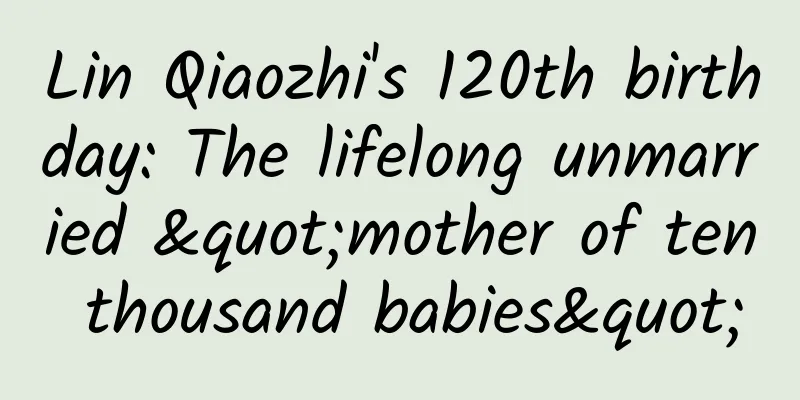Lin Qiaozhi's 120th birthday: The lifelong unmarried "mother of ten thousand babies"

|
Today marks the 120th birthday of Dr. Lin Qiaozhi, the founder of modern obstetrics and gynecology in China and the first Chinese director of obstetrics and gynecology at Peking Union Medical College Hospital. People continue to miss and interpret Lin Qiaozhi precisely because she still provides important inspiration today in the face of the increasingly indifferent modern medicine and the increasingly intensified conflicts between doctors and patients. Lin Qiaozhi once said: "As long as I am still alive, the place where I exist is the ward, and the value of my existence is to treat patients." Lin Qiaozhi (1901-1983) Xinhua News Agency In the medical community in China and even in the world, Lin Qiaozhi is considered a "legend". She was the only female academician of the first Chinese Academy of Sciences. During her medical career, she significantly reduced China's infant mortality and maternal mortality rates. In 2009, she was named one of the 100 people who moved China since the founding of the People's Republic of China. She never married in her life and personally delivered more than 50,000 babies, earning her the title "Mother of Ten Thousand Babies." Be a good doctor trusted by the people In 1901, Lin Qiaozhi was born into a Christian family in Gulangyu, Xiamen, Fujian. Her father named her "Qiaozhi", implying that she would be clever and innocent throughout her life. When she was 5 years old, Lin Qiaozhi's mother died of gynecological tumors. The pain of the death of her relatives made her establish a lifelong ideal: to do ordinary things with ordinary love. In 1929, Lin Qiaozhi, who was determined to become a doctor, became the first Chinese female doctor who graduated and stayed in Peking Union Medical College Hospital, and thus began her 54-year medical career. Lin Qiaozhi in her youth Image source: Xinhua News Agency In order to challenge the prejudice that women cannot hold scalpels, and for those Chinese women who knew nothing about obstetrics and gynecology, she resolutely chose obstetrics and gynecology, which was looked down upon by many people at that time. Here, when pregnant women were about to give birth, Lin Qiaozhi always held their hands and helped them wipe the sweat off their faces. Whitaker, an American who was the director of the Department of Obstetrics and Gynecology of Peking Union Medical College at the time, said disdainfully: "Dr. Lin, do you think you can become a professor by holding the hands of parturients and wiping their sweat?" It was this handshake and wiping sweat that made the patients trust her unconditionally. Decades later, Lin Qiaozhi had become the leading expert in obstetrics and gynecology in China, and she would still hold the hands of parturients and wipe their sweat. She perfectly explained her lifelong ideals and beliefs with her actions and achievements - to be a good doctor for the people. On September 22, 2016, 82-year-old Liu Yan wrote a thank-you letter to Lin Qiaozhi, which was 52 years late. The letter reads: "Before I entered the ward, I heard laughter: 'Where is the fat girl? Hurry up and show her to me!' A female nurse took my newborn daughter out of the nursery and handed her to Dr. Lin. Lin Qiaozhi held the fat girl, full of joy, and couldn't help kissing her chubby little face." At that time, Liu Yan had just lost her husband. The love and care of the medical staff of Union Hospital for her daughter rekindled her vision and hope for life. Time flies. One day, Liu Yan accidentally saw a report about Lin Qiaozhi on TV. The situation of that year reappeared in front of her, and gratitude came to her mind. So, there was this thank-you letter 52 years late. Liu Yan's story is just a wave in the ocean. In more than half a century, Lin Qiaozhi personally delivered more than 50,000 children. Many parents named their children "Nian Lin", "Huai Lin" and "Jing Lin" to express their respect and commemoration for her. Standing with ordinary patients Lin Qiaozhi, who devoted herself to obstetrics and gynecology, tried her best to avoid all matters unrelated to medical care and patients, and even declined many olive branches: In 1940, Lin Qiaozhi was sent by Union Medical College to study in the United States, but she declined the offer from the Department of Obstetrics and Gynecology at the University of Chicago. In 1949, Lin Qiaozhi, who was concentrating on her medical practice, even missed the founding ceremony of the People's Republic of China, which was only 1 km away from her. It was not until she heard the salute that she remembered the precious invitation on the table... She didn't care about fame or fortune, but focused on treating patients. Lin Qiaozhi always believed that medical care was not a privilege for the wealthy and powerful, but should be the right of everyone. She has been trying her best to ensure that more poor people can receive equal care. To this end, in 1940, despite the continuous war after the fall of Peking, she risked her life to open a private clinic in Dongtangzi Hutong, Dongcheng District, to treat women from the lower classes. In the end, she left behind 8,887 precious medical records in her six years of medical practice. Image source: Xinhua News Agency After her medical skills were spread far and wide, Lin Qiaozhi received an overwhelming number of letters from patients all over the country. One of the letters caught her attention. The person who wrote this letter was a female worker from Inner Mongolia named Jiao Haitang. At this moment, she was pregnant with her fifth child. Unfortunately, her first four children did not survive, and the last three children all died after they turned yellow after birth. She wrote this letter to beg Lin Qiaozhi to save the child in her belly. But Lin Qiaozhi knew very well that every word and sentence in the letter reflected the neonatal hemolytic disease that terrified doctors and had rarely been conquered even internationally. After receiving letters from the pregnant woman again and again, Lin Qiaozhi decided to give it another try. Sure enough, after the child was born successfully, he developed jaundice three hours later. She decisively decided to give the child a full-body blood transfusion. This couldn't be a more daring treatment. You know, today, it's difficult to give a whole-body blood transfusion to an adult, and it's even more difficult to give a child a blood transfusion, let alone help a newborn baby? Lin Qiaozhi's face was covered with a layer of fine beads of sweat, but she remained calm, which was difficult for ordinary people to achieve. She directed the doctor to draw out 15 ml of sick blood every minute, then drip in 8 ml of fresh blood, and add calcium solution. After three full-body blood transfusions, the 5-pound baby finally showed a healthy complexion. Image source: Xinhua News Agency This was also the first case of hemolytic disease patient surviving in the country. From then on, neonatal hemolytic disease was no longer a daunting "incurable disease". During her years of medical practice, Lin Qiaozhi always put her patients' future lives first while seeking to solve difficult and complicated diseases. American doctor John S. Bowles once commented on Lin Qiaozhi in his book "Western Medicine in the Palace of China - Peking Union Medical College Hospital": In China, she is regarded as a doctor hero. She personally delivered Yuan Longping In 2015, an elderly woman went to see Dr. Wang Shijun, director of the Department of Gynecology at Peking University People's Hospital, and showed him several copies of her elders' medical records for review. When seeing the signature on the medical record, Dr. Wang discovered that this record was actually written by Lin Qiaozhi, a leading figure in modern obstetrics and gynecology in my country. This medical record from 70 years ago has a total of 5 pages, half in Chinese and half in English, and the two are carefully compared. Regardless of whether it is the Chinese part or the English part, the handwriting is neat and clear at a glance. With the patient's consent, Dr. Wang took a photo of the medical record with his mobile phone and posted it on WeChat Moments. Judging from the content, this medical record was written in 1946 when Dr. Lin Qiaozhi was working at the Peking Central Hospital, and it records the condition of a woman named Wang. According to the basic medical condition, the patient had been misdiagnosed with uterine fibroids in other hospitals. When she came to Dr. Lin Qiaozhi, she was diagnosed with ovarian cyst and underwent surgery. The medical record has a total of 5 pages, half in Chinese and half in English. The two are compared meticulously, and both the Chinese and English parts are written neatly and clearly. The whole medical record is concise and to the point, and every sentence is the key point. Unlike the current medical records, which are very comprehensive but often lack the key points. The meticulous writing of the whole medical record, this style of "the truth is in the details" is really admirable and worthy of doctors' study. The above picture is the "Patient Informed Consent" in the medical record. It says: "Because I have a disease that requires surgery, I and my family are willing to have the surgery performed by the hospital. If there is an accidental danger to life or death, your hospital and the surgeon will have nothing to do with it. This is true." The patient and his "family" also signed the name at the end, and the date of the signature is March 4, 1946. "From the wording of this 'Informed Consent Form', it can be seen that the patient trusts the doctor very much." Doctor Wang sighed and said that the atmosphere of harmonious and friendly doctor-patient relationship was overwhelming in just a few sentences of the 'Informed Consent Form'. In addition to this handwritten bilingual medical record, netizens also discovered another birth certificate. Image source: CCTV At that time, the parents of the newborn had not yet thought of a name for the child, so they wrote "Yuan Xiaohai" on the birth registration materials. In the middle of the right page of the birth certificate was the footprints left by "Yuan Xiaohai" when he was born, and on it was Lin Qiaozhi's beautiful English signature. Later, the baby boy named "Yuan Xiaohai" was given an official name - Yuan Longping. Image source: Xinhuanet The difficult decision of staying single for life Talking about Lin Qiaozhi, there is also something that seems regrettable to outsiders: she delivered 50,000 babies, but she never got married and had children in her life. On the one hand, this was Lin Qiaozhi's personal ambition, and she was willing to devote all her energy to obstetrics and gynecology. But on the other hand, this was also due to a workplace environment that was not friendly to women at the time. The management of the Peking Union Medical College believed that women could not take care of both the roles of wife, mother and doctor at the same time, so women had to sign an agreement when they entered the hospital: if they got married or had children, they would be fired from the hospital unconditionally. It was not just Lin Qiaozhi, many female doctors at the Peking Union Medical College at that time were single, and they had to make a choice for the sake of their careers. Yan Renying, a student of Lin Qiaozhi, a famous obstetrician and gynecologist in my country and the honorary dean of Peking University First Hospital, also recalled: "Dr. Lin did not marry because of her status in Union Hospital. She was the only woman who could become a professor or director. If she got married, she would have no future." The professional background at the time forced Lin Qiaozhi to make a choice, but under the special circumstances, Dr. Lin still chose the patient. Image source: Xinhua News Agency Not only does she deliver babies, she has also made great contributions to the treatment of cervical cancer. In 1958, she and Zhang Chenfen worked together to develop a cervical cancer screening program, selecting Dongcheng District in Beijing as a pilot area and obtaining a large amount of survey data from 50,000 people. Then, based on the experience in Beijing, the team conducted examinations on more than 1.1 million women aged 25 and above in 20 cities in China. This was also the largest gynecological screening in the country at that time. On this basis, Lin Qiaozhi's team studied the causes of cervical cancer. According to statistics from Beijing, the proportion of early-stage cancers found in cervical cancer has increased by 8 times. As a result, many ordinary women can be diagnosed and treated early, thus avoiding the pain of cervical cancer. The Prime Minister's wife was not treated properly Focus on diagnosis, not the identity of the visitor Middle-aged Lin Qiaozhi One afternoon in the early 1950s, two middle-aged women in ordinary clothes came to the clinic. Lin Qiaozhi carefully examined them. The patient had lost her child forever, and Lin Qiaozhi hoped that she could relieve her pain. Lin Qiaozhi was never indifferent to other people's misfortunes. After seeing off the two patients, someone asked Lin Qiaozhi, "Do you know who is visiting you?" Lin Qiaozhi shook her head nonchalantly. She received too many patients every day, and she didn't care about their backgrounds or their names. The man said, "She is the wife of Premier Zhou Enlai." Lin Qiaozhi hurried to look at the medical records. She read the name Deng Yingchao and found it a little hard to believe. Deng Yingchao had a very unique impression of Lin Qiaozhi. She told others more than once: "Lin Qiaozhi is not an ordinary doctor. She has a special attraction to patients." Zhu De's wife Kang Keqing even wrote the following sentence in an article recalling Lin Qiaozhi: "Lin Qiaozhi's greatest characteristic in treating patients was that she treated them with the same seriousness and responsibility, regardless of whether the patient was a senior cadre or a poor peasant. She treated the patient, not the person." Lin Qiaozhi in the early days of the founding of New China What ordinary people think is "incomplete" is exactly what Lin Qiaozhi insisted on. In Lin Qiaoya's mind, medicine has its own purpose. It should lead to a pure realm, reaching the fragile instinct of human nature that longs for protection, security, and warmth. Lin Qiaozhi thought so, and she did so. In 1980, Lin Qiaozhi was hospitalized for cerebral thrombosis. During the three years of bedridden illness, Lin Qiaozhi still insisted on participating in the compilation of "Gynecological Tumors". The book of more than 500,000 words condensed Lin Qiaozhi's lifelong exploration and research on gynecological tumors, and recorded her last contribution to the medical cause. On April 22, 1983, Lin Qiaozhi died. In her dying moments, she seemed to be back in front of the tense operating table, shouting: "Bring it quickly! Forceps, forceps..." The nurse brought something and stuffed it into her hand. A few minutes later, a calm and peaceful smile appeared on her face, "Another fat baby, 3 babies were delivered in one night, so good!" This was her last sentence before she died. In her article "In Memory of Dr. Lin Qiaozhi," Bing Xin wrote: "She was a flame and a magnet. Her life of serving the people was extremely full and fulfilling." "I am a doctor. I have experienced too many life and death situations. I am not afraid of death." After being hospitalized, Lin Qiaozhi said calmly in an interview with China Youth Daily, "People understand me, and I understand myself better. I have no guilt, no worries, no regrets, and I can die with my eyes closed." After her death, the Department of Obstetrics and Gynecology of Peking Union Medical College entered its heyday. Among her students, some became the main leaders of the Department of Obstetrics and Gynecology of medical schools, some became academic experts with outstanding achievements, and some made major breakthroughs in scientific research and reached the world's advanced level. Internationally, the main indicators for measuring the health level of a country's residents are life expectancy, infant mortality rate and maternal mortality rate. In the 1920s, when Lin Qiaozhi first entered Peking Union Medical College and entered the door of medicine, China's neonatal mortality rate was 275‰, most of whom died of preventable tetanus; the maternal mortality rate was 17.6‰, and the causes of death were mostly avoidable obstetric diseases such as puerperal fever and heavy bleeding. In 2018, China's neonatal mortality rate was 6.1‰ and maternal mortality rate was 0.183‰, both reaching a relatively high level in developing countries. Lin Qiaozhi never had children, but she knew that mothers always put a lot of thought into their children. She was always extra caring and considerate to her young colleagues in the obstetrics and gynecology department who had children. Many female doctors remember that whenever Lin Qiaozhi introduced them to guests, she would often add: "She is still a mother." Lin Qiaozhi had two savings books: one for her salary savings and the other for her income beyond her salary, such as subsidies for meetings of the National People's Congress and the Chinese People's Political Consultative Conference, and travel expenses regularly paid as a member of the Chinese Academy of Sciences. She believed that the former was her income from labor and could be used to support relatives and friends, while the latter should be used for other purposes. She left her will: all her savings of 30,000 yuan were donated to the nursery of Union Hospital to relieve the worries of mothers in Union Hospital. Her body was used for medical dissection in the hospital, and her ashes were scattered on the sea of Gulangyu Island, her hometown. References [1] Reading, Zhang Qingping, The Biography of Lin Qiaozhi: The Essence of Medicine 20181107 | CCTV Science and Education [2] Reading, Zhang Qingping, The Biography of Lin Qiaozhi: The “incomplete” things done by the mother of Wan Ying 20181106 | CCTV Science and Education [3] Female doctors at Peking Union Medical College Hospital. Banyuetan.org. http://www.banyuetan.org/chcontent/wh/dt/2013516/39488.shtml [4] Lang Jinghe, The Patron Saint of Women [5] Jiang Yuhong and Mary Brown Block, “Collection of Essays in Commemoration of the Centennial of Union Medical College” Comprehensive sources: Xinhua News Agency, CCTV Science and Education, Guangming.com, Healthy China, Dingxiang Doctor, Sanlian Life Weekly, etc. |
<<: Why did Harry Potter kiss under the mistletoe?
Recommend
User Activation: Breaking Down Luckin Coffee’s New User Activation Process
There are many ways to attract new customers to y...
IFR: Understand the current status and trends of global industrial and service robots in one article
The International Federation of Robotics (IFR) re...
Genes are also divided into "long and short"? It's related to aging! New research finds that short genes are more active than long genes
Author: Duan Yuechu Your browser does not support...
Can toothpaste be dipped in water? Does water from an electric kettle damage your nerves? Let's find out all at once!
How many of these rumors have you seen recently i...
4 ways to pull seed users
It’s a relatively new product and I don’t think t...
Growth Strategy: How to use AB testing to evaluate and optimize activities?
The e-commerce industry is full of promotional ac...
How can one operate a product like Xiaokaxiu on his own?
Recently, a friend asked me this question: "...
How much is the price for being an agent of Qingxu Perfume Mini Program? Qingxu perfume applet agent price inquiry
How much does it cost to be an agent of Qingxu Pe...
What if the Earth gets cold or hot? In fact, it also has a "big air conditioner"
Forests are the earth's natural air condition...
Do you know how many world cultural heritage sites there are in China? This shorthand method will give you plenty to talk about →
On July 27, 2024, the 46th UNESCO World Heritage ...
Xiaohongshu KOL screening, placement, and review tutorial
Since its inception, KOL has possessed strong tra...
Honor V20: Not only the most affordable Kirin 980, but also a flagship phone with comprehensive quality
At the end of the year, when people all over the ...
User promotion: 6 common forms of bringing in new users
Today's article would like to explain to you ...
How to write an activity planning proposal? Here are 4 tips for you!
If your boss is a fanatic about offline and onlin...









